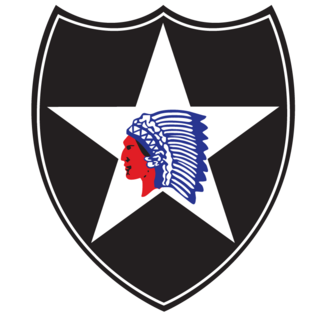
The 2nd Infantry Division ("Indianhead") is a formation of the United States Army. Its current primary mission is the pre-emptive defense of South Korea in the event of an invasion from North Korea. There are approximately 17,000 soldiers in the 2nd Infantry Division, with 10,000 of them stationed in South Korea, accounting for about 35% of the United States Forces Korea personnel.
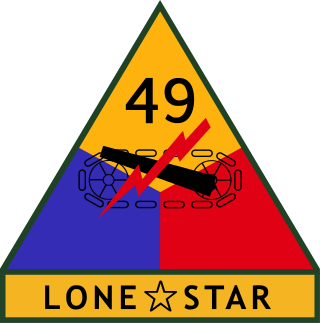
The 49th Armored Division —nicknamed the "Lone Star"— was an armored division of the Texas Army National Guard during the Cold War.

The 35th Infantry Division, formerly known as the 35th Division, is an infantry formation of the United States Army National Guard headquartered at Fort Leavenworth, Kansas.

The South Dakota National Guard is part of the South Dakota Department of Military & Veterans Affairs. It was created in 1862 as the State Militia. Its headquarters is located in Rapid City, South Dakota. It consists of the South Dakota Army National Guard and the South Dakota Air National Guard.

The 50th Armored Division was a division of the Army National Guard from July 1946 until 1993.

The 169th Field Artillery Brigade is an artillery brigade in the US Army National Guard. It is part of the Colorado Army National Guard.

The 6th Field Artillery Regiment is a Field Artillery Branch regiment of the United States Army first activated in 1907 from numbered companies of artillery. It was first organized with two battalions.
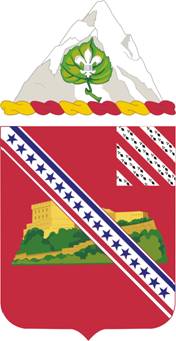
The 17th Field Artillery Regiment is a field artillery regiment of the United States Army first formed in 1916.
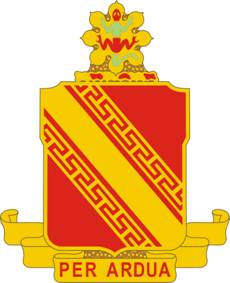
The 44th Air Defense Artillery Regiment is an Air Defense Artillery regiment of the United States Army, first constituted in 1918 in the Regular Army during World War I. During World War II the unit served as the 54th Coast Artillery Regiment

The 157th Field Artillery Regiment (First Colorado) is a United States Army Regimental System field artillery parent regiment of the United States Army National Guard, represented in the Colorado Army National Guard by the 3rd Battalion, 157th Field Artillery Regiment, part of the 169th Field Artillery Brigade at Colorado Springs.
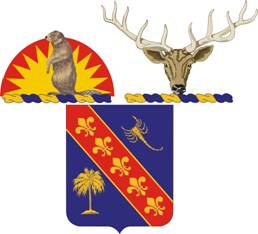
The 148th Field Artillery Regiment is a Field Artillery Branch regiment of the Army National Guard.
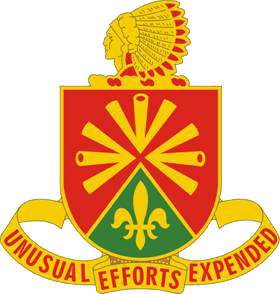
The 158th Field Artillery Regiment is a Field Artillery regiment of the Army National Guard.
The 203rd Engineer Battalion is a combat engineer battalion of the Missouri Army National Guard.
The Central Army Group (CENTAG) was a NATO military formation comprising four Army Corps from two NATO member nations comprising troops from Canada, West Germany and the United States. During the Cold War, CENTAG was NATO's forward defence in the southern half of the Federal Republic of Germany (FRG). The northern half of the FRG was defended by the four Army Corps of NATO's Northern Army Group (NORTHAG). During wartime, CENTAG would command four frontline corps. Air support was provided by Fourth Allied Tactical Air Force.
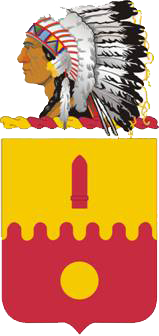
The 1st Battalion, 160th Field Artillery Regiment is headquartered in Chandler, Oklahoma. It is a part of the 45th Infantry Brigade Combat Team, Oklahoma Army National Guard.

The 45th Fires Brigade is a modular field artillery brigade of the United States Army headquartered in Mustang, Oklahoma. It is a part of the Oklahoma Army National Guard.

The 103rd Field Artillery Regiment is a regiment of the United States Army. The only currently existing component is the 1st Battalion, 103rd Field Artillery Regiment, a unit of the Rhode Island National Guard. The regiment was originally constituted in 1917, but it descends from predecessor units dating back to 1801.

The 115th Field Artillery Brigade, known as “Cowboy Thunder” is an artillery formation of the United States Army, raised by the Wyoming Army National Guard. It is headquartered in Cheyenne, Wyoming. Its history stretches back to the 1800s when Wyoming was a U.S. territory. The first muster formation was in 1888 as 1st Regiment Infantry. It was redesignated as the 115th Field Artillery Brigade September 1, 1978.

The 142nd Field Artillery Brigade is a field artillery brigade in the Arkansas Army National Guard (ARNG). The 142nd is currently under administrative control of the 29th Infantry Division.
The 434th Field Artillery Brigade is a training/ artillery unit under the United States Army Fires Center of Excellence, a formation under TRADOC. The brigade conducts Basic Combat Training for new enlistees in the U.S. Army.


















